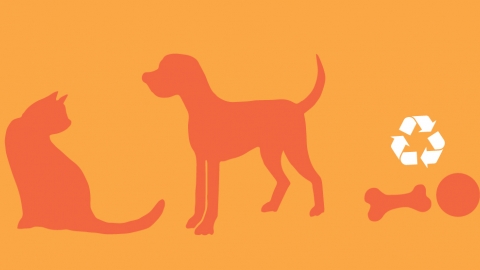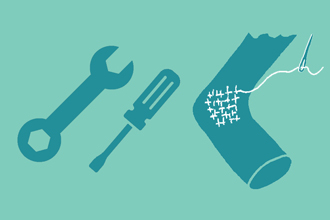
How to be an eco-friendly pet owner
There are so many small changes we can make in our own lives to be more environmentally friendly, including when we are caring for our pets. Just changing the products we use and small choices we make can have a huge impact on wildlife and the environment as a whole.
Changing the small, everyday choices we make can have a huge impact on wildlife and the environment.
Walking to a nearby park rather than driving to the dog park, or attaching a bell to your cat’s collar to reduce the risk of them catching wildlife can make a world of difference over the years.
There are also impacts that dogs can have on the environment that you may not be aware of, like contributing to river pollution. But the good news is that there are simple things you can do to ensure that you and your dog taking care of the environment!
So, whether you’re seasoned in the art of caring for furry companions, or you’re taking the first steps to becoming a pet owner, here are some tips to help you minimise your pets’ environmental pawprint.
Top tips for being an eco-friendly pet owner:
Tread lightly in the countryside
When exercising your dog, follow any local guidance or on-site signage to ensure that your pet isn't disturbing wildlife, or stressing the grazing animals that create and maintain habitat.
When visiting rivers, keep your dog out of the water if they have recently been treated with a topical flea treatment. These are essentially pesticides which can leach into the water and cause harm to aquatic wildlife, like dragonfly, beetle and mayfly larvae.
If the site you're visiting allows dogs to swim, encourage your dog to stay in the water rather than climb in and out repeatedly, especially if there are bankside plants at risk of being trampled.
Bare soil erodes easily, releasing sediment into the river which is harmful to the insects and fish that live there. You might not know that severe erosion that even lead to bank collapse! Use areas of hard standing if there are any - some sites even have specially-installed 'dog dips' providing access points to the water which don't contribute to erosion.
The British Veterinary Association also have advice on responsible use of parasiticides on their website.
Buy planet-friendly pet food
If your pet eats a plant-based diet, the main area you should focus on is packaging. If you can buy food loose, carrying it using your own reusable containers, this is the best way to avoid packaging. Otherwise, try to find food with recyclable packaging, or buy in bulk as long as you can be sure that the food will be used before its expiration date.
Meat is resource-intensive to produce, can be a source of pollution, and carries a significant environmental footprint. For cats and dogs on meat-based diets, pick food with lower impact meats like chicken and try to stay away from beef, whose carbon footprint far exceeds that of any other meat. While they might seem like a good idea, human-grade meats used in high end pet foods put additional pressure on our food production systems: try looking for pet food made from by-products of the meat industry like bonemeal and organ meat, or with high plant-based content. If you’re after fish-based food, make sure it’s certified sustainable.
Make homemade treats
With plenty of inspiration and recipes online, there’s never been a better time to have a go at making your own pet treats! Making your own and storing them in a reusable, resealable container can be a great way of skipping the wasteful packaging that comes along with most commercially available pet treats, and leaving out environmentally damaging ingredients like unsustainable palm oil.
Eco-friendly toys
Having new toys to play with is an enriching experience for your pet. Next time you’re thinking of introducing a new toy for your pet to play with, skip the usual pet shop gotos and consider alternatives:
- Get creative with your junk! Take a look around the house at what you might be throwing out soon. A ball of foil can entertain a cat for hours, while a knotted old t-shirt can be a great doggy pull toy. For smaller creatures like guinea pigs and rabbits, try crafting old toilet tubes into balls and hiding bits of food inside, and watch as your pet chases and rolls the little cardboard ball around to get at the treat inside.
- If you are buying new (used pet toys aren’t always a good idea), look out for toys made from sustainable or recycled materials, that are preferably recyclable or biodegradable at the end of their lives. Don’t forget to dispose of used toys properly, avoiding landfill waste if possible. Contact your local animal shelters if you have any lightly used or unwanted toys – they’ll likely be glad of the support.
Be careful with poo
Cleaning up after your pet is important, whether it poops in the park or uses a litter tray. Small herbivorous pets like rabbits, guinea pigs, or birds have harmless poo. If you have a compost heap, it can safely be added to the pile along with any bedding that will decompose including newspaper. Dogs and cats are a different story, as their faeces are a health hazard, and need special consideration.
Dogs
Chances are, you pick up after your dog three times a day using a black plastic disposable bag. Over a year, that’s over a thousand plastic bags going to landfill! But fret not, here are some alternatives to consider.
- Bury it: If you live in the countryside with plenty of open green space, you can dig a hole at least 15cm deep to bury it in, making sure you cover it up properly and tightly.
- Composting: Compostable bags will not decompose in landfill. If you’re using these, you could compost them at home, but do not use dog poo compost on anything that you intend to eat! It’s fine to use for decorative plants, but best kept in a separate pile or avoided unless you know what you’re doing.
- Recycled bags: Failing these options, using bags made from recycled plastic or using plastic that would be going to the bin anyway is better than using freshly manufactured plastic.
Cats
- Don’t flush! Sewage treatment systems are not equipped to treat the parasites found in cat waste, so flushing it down the toilet is out of the question.
- Cat litter: Check what your cat litter is made of. Many cat litter formulations contain sodium bentonite clay; a clay sourced using a destructive strip-mining method. Ideally, you should be using materials that you would compost in your own garden such as sawdust, shredded paper, or even leaves. There are eco brands available if you don’t want to go the DIY route.



